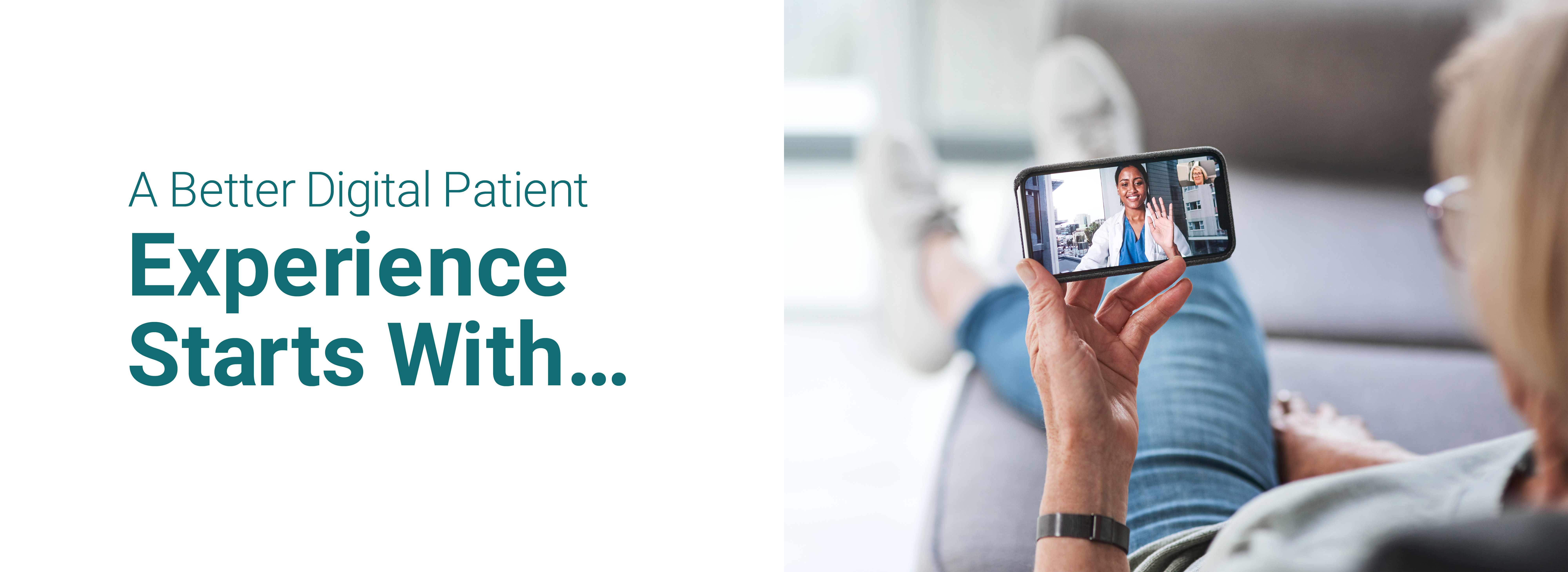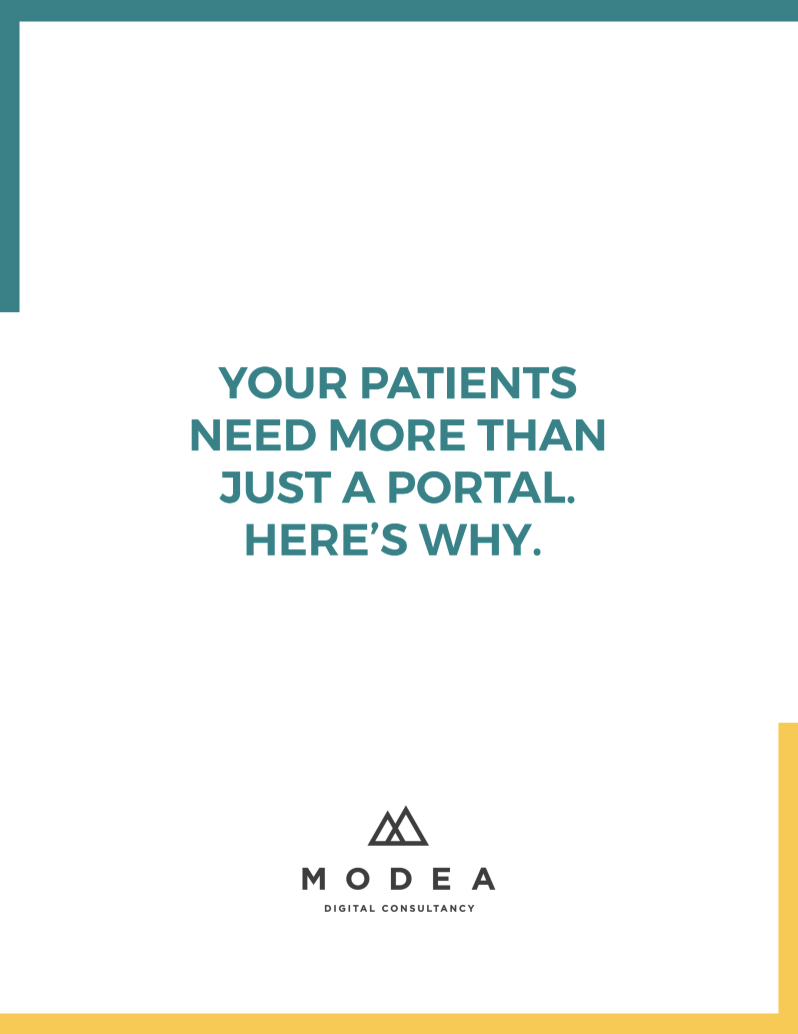
A decade ago, the concept of patient experience in healthcare was primarily centered around the in-person interactions between patients and their healthcare providers. The quality of care was often judged by factors such as bedside manner, wait times, and the physical environment of healthcare facilities. Over the last few years, we have ushered in a new kind of patient experience. This experience is centered around patients’ digital access to care and the tools offered by healthcare organizations. Today’s patients want to be in the driver’s seat of their own care and the right digital experience gives them the keys.
The healthcare industry is using technology more to connect with patients, especially since the pandemic sped up the use of digital tools in care. This change follows trends in other areas, where people expect the same ease and efficiency in healthcare as they do with technology and retail companies. The increasing use of smartphones and the internet has transformed patients into patient-consumers. While new technologies can make care more personal and efficient, understanding what patients want and expect is still very important. For example, even though the number of smartphone users has gone up by 74% in the last five years, only 49% of healthcare systems offer a mobile app. Not having digital tools can make things less convenient for patients and hurt their trust in healthcare providers.
We surveyed over 1,200 healthcare consumers in the United States. We found that younger patients, accustomed to easy digital experiences like Amazon and restaurant booking websites, have the most difficulty with digital healthcare tools. This shows that healthcare tools need to be easy for everyone to use. If not addressed, healthcare providers risk losing younger patients who expect seamless digital interactions. These patients are seeking long-term care providers for their families. New technologies like telemedicine, electronic health records (EHRs), and mobile health apps are promising. However, healthcare organizations must ensure these tools are easy for all patients to use, accessible everywhere, and compatible with all devices.
By making sure digital tools are easy for patients to use, fixing any tech problems, and focusing on how patients interact with them, healthcare systems can improve care and build trusting relationships. Learning from other industries can also personalize patient experiences in healthcare.
Lessons from Out of Industry Giants
Big names like Amazon, Netflix, Walmart, and Target are always coming up with new ideas. They consistently keep up with what customers want. These are brands we use all the time, and they seem to have figured out the best way to make digital experiences that everyone else tries to copy. For example, Amazon has changed online shopping with features like one-click ordering. With this, you can buy something in just five seconds. They also have tools to help you find what you want and learn about products, and things like Alexa use artificial intelligence to make life easier.
Netflix, the top subscription-based streaming service, uses artificial intelligence algorithms to customize user experiences. This means subscribers get content that matches their tastes. This focus on personalization, along with ongoing technological improvements, drives Netflix’s growth and success in the competitive streaming market.
Walmart is upgrading digitally, using new technology to improve shopping and streamline operations. They use automation, machine learning, and data analytics to turn data into useful insights, making things run smoother and keeping customers happy. Their focus on mobile features and digital changes shows how serious they are about using technology to transform retail.
These industry giants emphasize the importance of continuous innovation and investment in digital solutions. They aim to provide exceptional customer experiences in today’s competitive market.
Healthcare is now facing increased competition, with patients expecting more choice and transparency. Organizations that provide the best experiences to their patients are gaining market share, whether they’re offering care locally or to patients far away.
How Do Healthcare Giants Compare?
Despite advancements, large healthcare systems still lag in delivering personalized, easy, accessible digital experiences compared to other industries. While strict regulations protect patient privacy, there are still ways to provide the right tools and experience – organizations just need to figure out how. For instance, when booking appointments, patients often face a complicated process. They have to click multiple times to input details like location, language, concerns, and insurance. This complexity, sometimes requiring over 20 clicks, makes the experience less user-friendly.
One widely recognized national health organization requires a prospective patient to call to make an appointment. Information about the organization’s patient-centered mobile app is not shown on the homepage or in the drop-down menu, requiring some searching to find the relevant page. While you can download the app, you must receive a clinic number and activation code before your first visit. This ensures that not just anyone can create an account.
Two other well-known health organizations offer the convenience of scheduling appointments directly through their websites, but the process could be more user-friendly. When attempting to book an appointment online, users are redirected to MyChart. There, they must either log in or create an account, whether for a virtual or in-person visit. These extra steps can pose a barrier for some individuals.
The lack of immediate, unauthenticated actions means that without logging in, patients can do very little. Overall, some progress has been made, but the digital patient experience in healthcare still requires significant improvements. Personalization, simplicity, and accessibility need enhancement to truly meet modern consumer expectations.
Enhancing the Digital Patient Experience: Luminis Health’s Innovative Approach
Some healthcare organizations prioritize enhancing the digital patient experience in their digital transformation efforts. Luminis Health exemplifies this commitment, streamlining and personalizing various aspects of the patient journey. Instead of using a typical doctor search interface, we collaborated with Luminis Health to create a more user-friendly system. This enables individuals to schedule appointments directly online, whether as guests or through a customized MyChart integrated scheduling experience. This integrated approach allows for seamless scheduling within the website, eliminating the need for repeated authentication at each step.
By leveraging data from MyChart, Luminis offers a personalized dashboard experience for logged-in patients. Through data analytics, they deliver relevant information and recommendations based on patients’ health profiles, location, and preferences. Inclusivity is also a top priority. Thorough accessibility testing ensures a consistent and high-quality experience for all patients, including Spanish speakers. This proactive digital transformation underscores Luminis Health’s commitment to providing accessible, personalized, and user-friendly healthcare.
Strategies for Improving the Patient Experience
To create an exceptional patient experience, it’s vital to nurture a culture that prioritizes patient satisfaction and engagement. This should be emphasized across the entire organization. Gaining support from stakeholders at every level of leadership ensures the availability of resources and backing for initiatives aimed at improving the patient experience. Encouraging collaboration between departments like Marketing and IT is also an important consideration. The patient experience should be a joint effort rather than the sole responsibility of one department. It’s common for organizations to fund digital assets through the capital process during these efforts, which is the right approach.
Deep research to understand the specific needs and preferences of your patient audience is key for creating effective healthcare experiences. This process involves utilizing a variety of research methods, including surveys, focus groups, and interviews to gather valuable insights. These insights not only provide valuable information about patient preferences and needs but also underscore the human element inherent in healthcare.
How do the touchpoints experienced by patients influence their choice of care provider and their loyalty to them?
Emily Wayman, a senior UX Researcher at Modea, highlights the significance of recognizing the emotional journey of patients when using digital healthcare products, saying,
“patients experience a wide range of emotions while interacting with healthcare products, from worry and anxiety to happiness and relief. Treating them with empathy and understanding, rather than using overly technical language, is critical for fostering a sense of connection and trust.”
Investing in solid EHR systems, easy-to-use websites, and comprehensive mobile apps can enhance healthcare experiences. These digital tools enable healthcare to match the convenience and efficiency of other industries. These tools streamline processes and improve access to care for patients. We asked our VP of Product, Megan Adkins, how she would create the best digital experience:
“Creating a single, integrated platform that provides patients and their families with all the essential tools they need to manage their care in one place, eliminating the hassle of using multiple apps or websites.”
This streamlined approach to a digital health tool not only simplifies care management but also eliminates the frustration of navigating multiple disjointed platforms. More than 84% of patients are likely to remain with their provider if the provider is easy to work with. Therefore, simplifying the digital patient experience and facilitating care management through an integrated tool will not only meet consumer expectations but also enhance patient retention and satisfaction.
Investing in digital infrastructure is crucial for improving the patient experience, but there also needs to be consistency across all patient interactions, whether in-person or online.
Modea’s Chief Operating Officer, Chris Riegger says,
“a lot of health systems build great tools and features, but don’t do the hard work of knitting those together into a coherent, unified customer experience that appropriately represents the brand. That has to happen.”
President of Modea, Bryce Cannon, adds,
“to gain efficiency, and optimize the customer experience we need to shift to a platform based approach that consolidates the technology and allows us to focus resources on developing great, consistent experiences across channels rather than maintaining disparate technologies that don’t talk to each other.”
Interestingly, Katie Cox, a senior UX/UI designer at Modea also shares a similar viewpoint, saying,
“digital experiences don’t exist in a vacuum; they’re part of a larger ecosystem. So, they become better when the transition between physical and digital becomes more seamless.”
To stay ahead in the healthcare sector, it’s valuable to monitor what others are doing. Analyzing how digital changes affect your organization is also crucial for maintaining competitiveness. This helps you identify areas to improve and ensures you meet industry standards. Your organization can adapt and develop new ideas by actively keeping up with new digital trends and patient preferences. This positions it as a leader in healthcare by meeting the evolving needs of patients.
Health organizations that earn consumer loyalty are those that take an empathetic approach to improve access, experience, and outcomes. They offer a personalized health journey focused on building trust and making things convenient for patients.
What should you take away?
Improving the patient experience isn’t just about using new technologies; it’s about making the journey seamless, intuitive, and personalized. By studying both industry giants and leading healthcare providers, healthcare providers can greatly enhance the patient experience. Making strategic organizational changes can further improve the patient experience. This can lead to higher patient satisfaction, better health outcomes, a stronger competitive position in the market, and increased ROI.
Investing in patient experience is an ongoing process that requires continuous evaluation and adaptation. By prioritizing patient needs and leveraging technology, healthcare organizations can build lasting relationships with their patients. This approach enables them to provide the highest quality care.


